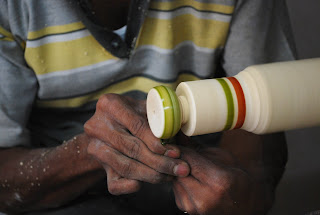
I started of by using cardboard cones which is sold as scrap from spinning mills and covering it with fabric stitched with the guidance of a textile student-aditi.

I tried to reduce the stitches in the making so i used old Tyre tube to hold the fabric in place.

walking down raja market i found these ready made pouches that fit the cones perfectly.
i felt this process of packaging was getting messy and over the budget.

moving on to working with cardboard and talking to a visual communication student- nalisha
we started to do more research and thinking of a way to see the product when its packed.

a dirty prototype with paper showing the opening in the sides.

paper templates for the packaging

first trial with cardboard. It was a good start where the top was safely packed but the packing space could be reduced.

packaging using recycle cardboard.

side profile where the top can be seen .

unwind the rope to open the package

outer pack opens where the user manual and story of the top is there.










































